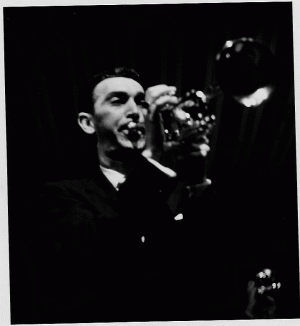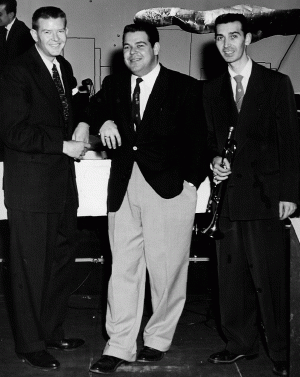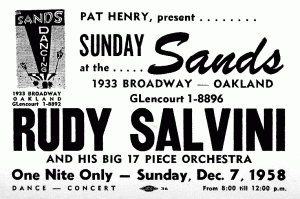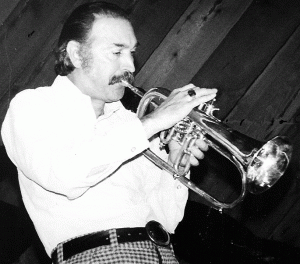by Alex Walsh
Printed in the Musical News, January/February, 2008
“We all wanted to play. We all wanted to be involved,” says trumpet player and band leader Rudy Salvini, “That’s the inspiration to keep going. I had a burning passion right away.”
Today, he still feels that burning passion. It’s what keeps him rehearsing and gigging with his band, The Rudy Salvini Big Band. “At this point, it’s a labor of love,” he says,” It’s a matter of having good musicians. Art Dougherty’s been there 25 years – Allen Smith, Tom Hart, almost 50 years.”

Rudy was born in Oakland in 1925. He says that he had no relatives in music, but while growing up, he was exposed to music because his mother sang all the time. She was born in Italy and came to the U.S. at the age of 6. His father had many jobs, including as a construction worker and an auto mechanic. His parents were always supportive of him in school. In the 5th grade, when the music instructor came around with instruments to recruit students for the band, Rudy picked the trumpet. That was it.
When Rudy was 11, his father was killed in an industrial accident while working for a cement company that provided concrete for the construction of the San Francisco / Oakland Bay Bridge. He then moved in with his grandparents.
As a teenager, Rudy collected records. He recalls buying stock arrangements for .69 cents and starting rehearsal bands that met at his house after school. “The 1940s were a great time to go to high school,” says Rudy. ”It was the Big Band era – Harry James, Benny Goodman, Duke Ellington. We would go out to see them in the clubs. I remember the first time I heard Stan Kenton. I was blown away! I couldn’t believe it. It was simply amazing. I couldn’t have been more than 15.”
Soon, Rudy and his buddies could be found hanging out talking shop–how to play, how to read, how to interpret–at the popular Busy Bee restaurant, which was downstairs from the main rehearsal hall in Oakland. Rudy says that these Busy Bee sessions were invaluable because there were no music schools or music camps for teenagers, and no minus-one books and records available like today. The only way to learn was to talk to other musicians, and learn on the job.
After high school, Rudy started his own 12-piece dance band, which included his friends John Coppola and Johnny Markham. They played anywhere they could, including USO dances. “Pretty soon the union got to know who I was and said ‘hey, why don’t you join us?’” recalls Rudy. ”So I went down to see the business agent in Oakland and joined.” He was nineteen.
At the recommendation of his high school music teacher, Rudy enrolled in the music program at SF State. A year later, he was drafted. “The war had just ended with Germany, but not with Japan.” he says, “I was very lucky that I went to Germany.”
Stationed at Wiesbaden, Germany, with the 761st Army Air Force band, Rudy lived in a hotel in town and played almost every night. “Being at SF State and majoring in music probably gave me more experience,” he says, ”so the army made me the leader of a dance band, which gave me a couple of extra stripes.” At the recommendation of friends, Rudy joined the 314th Army Forces Band, the top general’s band, which boasted the best musicians from all over Europe. They played at the Wiesbaden Opera house for the Army Air Force Radio Network. It was a full band with a full string section and four singers, including a young Tony Benedetto (now known as Tony Bennett).
After two years, Rudy returned to San Francisco and continued his education at SF State under the GI bill. His classmates included Allen Smith, Cal Tjader, Paul Desmond, and Wayne Allen, among others. He got married and graduated in 1951, determined to be a professional musician. He soon realized that it was pretty tough to make a living, so he returned to college and finished his teaching credential in 1953. He then gave himself five years to see what would happen with music professionally. Rudy became one of the many casual musicians hanging out at the Union Hall on 230 Jones Street, waiting for work. He soon discovered that the phone attendant was the most important person to know.
“You need a trumpet player when? Thursday?”
“I’m free Thursday!” Rudy would say…
“That’s the way it would happen,” says Rudy, “Those things were happening all the time for all of us. We played everything.”
In 1954, Rudy was recruited by many of his colleagues to start his first big band. By this time, the big band era was long gone, and it was hard to find places to play. The band became a rehearsal band and a vehicle for writers that wanted to hear their music played. Every Saturday at 230 Jones Street, he was there. “People would bring their music, and we would play it,” says Rudy,” That started me off.”
His career got a boost when Pat Henry, a jazz disc jockey from KROW, became his mentor. He set Rudy up on many of the first big band gigs, including Sweet’s Ballroom, and Sands Ballroom. Pat was well known, so when someone wanted a band for a concert, he would get Rudy in on it. He also set him up with a recording contract. In 1956, Rudy’s band recorded an album called “Intro to Jazz” for San Francisco Records. It included a couple standards and many originals, and according to Rudy, it was very progressive for the time. The record sold locally and was played on the radio. The contract called for three more albums, but the owner died suddenly, and that was the end of San Francisco Records.

Rudy in 1954 with Promoter & Mentor Pat Henry (left), and Arranger Jerry Cournoyer (middle)
Like most AFM locals at the time, Local 6 was racially segregated. Local 669, the black local, was a subsidiary of Local 6. It covered the same territory as Local 6, although black musicians were not allowed to play east of Van Ness. “Socially, everybody interacted,” recalls Rudy. ”There was never a race thing with musicians. There was nothing that would keep us apart. Great players are great players. I would go down to Bop City and sit in. If you were good enough, you could get up there and play.” Rudy says when he was in college he used to sit in with Vernon Alley at the Black Hawk on Sundays. Not everyone felt the same way, though, and Rudy remembers it was a sad event, in 1956, when Local 6 voted not to integrate (the two locals were finally merged by court order in 1960).

Rudy continued to play casuals, and concerts with his big band. He remembers Pat Henry calling him to provide the big band for his first name artist, Shelly Manne, who wanted to do a recapitulation of his album, “Manne, That’s Gershwin.” “They sent the music up from LA, and we backed up Manne’s quartet,” recalls Rudy. One he’ll never forget was playing with Louie Armstrong at the Civic Auditorium.
In 1958, Rudy played the first Monterey Jazz Festival as the Rudy Salvini Big Band. That fall he played with Dave Brubeck, Cal Tjader, and Ron Crotty at the Blackhawk in San Francisco. “When you start working with that caliber of musicians, that’s what you want to do,” he says. But the life of the casual musician was beginning to take its toll. His first marriage had ended in divorce, with lack of money being a major factor. In 1959, he called Pat Henry up for some advice:
”Pat, I just got an offer to teach in Pacifica, should I take it?”
“Of course, take it!

Early 1960s, North Beach
Rudy taught elementary music to kids in the 5th through 8th grade. He says that they’re great for teaching at that age because they’re like sponges. He retired in 1985. “I really loved my job,” says Rudy. ”I had the best of both worlds–stability, and a great mentor helping me, involving me with wonderful players.” His school was very supportive of his musical activities, which continued to thrive. He played the Monterey Jazz Festival seven more times. His rehearsal band was still going on Saturdays at Local 6. Other highlights include the “Jazz In The City” series and playing for Mel Tormé. In 1967, he performed at the first Stern Grove Jazz Festival with Vince Guaraldi and Turk Murphy. The 1970s continued along in that same vein.

Early 1970s
“In 1987, I made a change. I knew the big concerts for jazz were pretty much gone. Big Band venues were a thing of the past. I had only two options left – fold up the tent and go away, or become a dance band.” Right now Rudy rehearses once a month at the union with his band and performs once a month at the Alameda Elks Ballroom.
“I have no complaints,” he says. ”If I had to do it all over again, I’d do the same thing. I really would. At one point, sometimes the passion was the money. As time went on the passion became the professionalism of producing good music—which should be there all the way along. What I’m saying is the money angle doesn’t mean anything anymore. But when you’re young and you have a family, you need to have that bread.”

“I had a wonderful career teaching, and I had a wonderful career with my bands, right from the get go. I don’t see any reason to stop,” says Rudy. “As Duke Ellington said, ‘And then what do I do?’”
